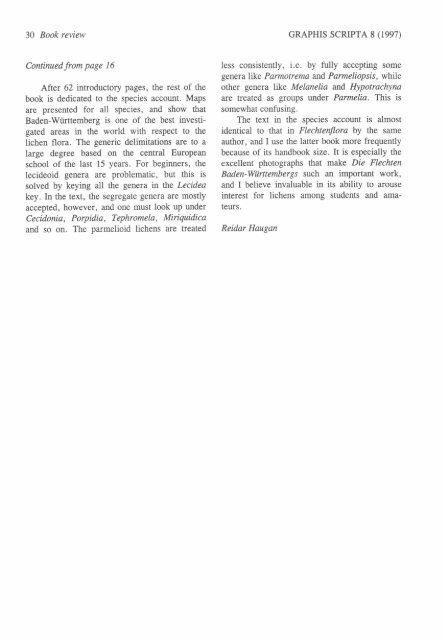GMPHIS SCRIPTA - Universitetet i Oslo
GMPHIS SCRIPTA - Universitetet i Oslo
GMPHIS SCRIPTA - Universitetet i Oslo
Create successful ePaper yourself
Turn your PDF publications into a flip-book with our unique Google optimized e-Paper software.
30 Book review<br />
Continued from page 16<br />
After 62 tntroductory pages, the rest of the<br />
book is dedicated to the species account. Maps<br />
are presented for all species, and show that<br />
Baden-Wtrttemberg is one of the best investigated<br />
areas in the world with respect to the<br />
lichen flora. The generic delimitations are to a<br />
large degree based on the central European<br />
school of the last 15 years. For beginners, the<br />
lecideoid genera are problematic, but this is<br />
solved by keying all the genera in the Lecidea<br />
key. In the text, the segregate genera are mostly<br />
accepted, however, and one must look up under<br />
Cecidonia, Porpidia, Tephromela, Miriquidica<br />
and so on. The parmelioid lichens are treated<br />
GRAPHTS SCRTPTA 8 (1997)<br />
less consistently, i.e. by fully accepting some<br />
genera hke Parmotremn and Parmeliopsis, while<br />
other genera like Melanelia and Hypotrachyna<br />
are treated as groups under Parmelia. This is<br />
somewhat confusing.<br />
The text in the species account is almost<br />
identical to that in Flechtenflora by the same<br />
author, and I use the latter book more frequently<br />
because of its handbook size. It is especially the<br />
excellent photographs that make Die Flechten<br />
Baden-Wiirttembergs such an important work,<br />
and I believe invaluable in its ability to arouse<br />
interest for lichens among students and amateurs.<br />
Reidar Haugan

















